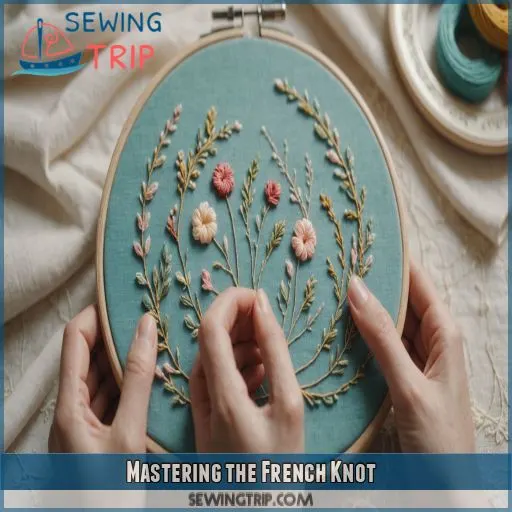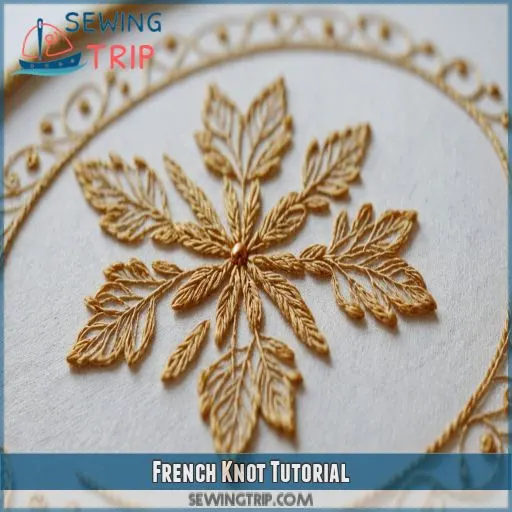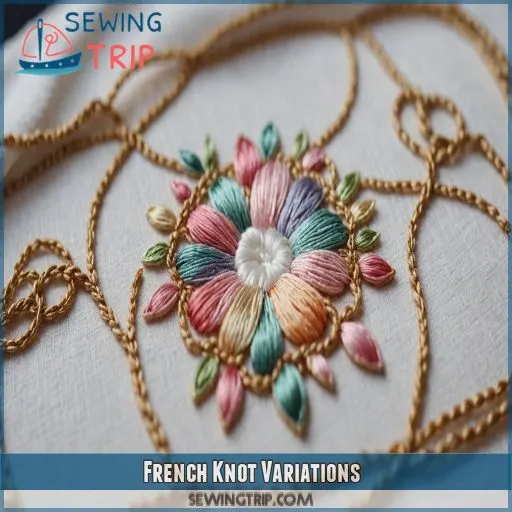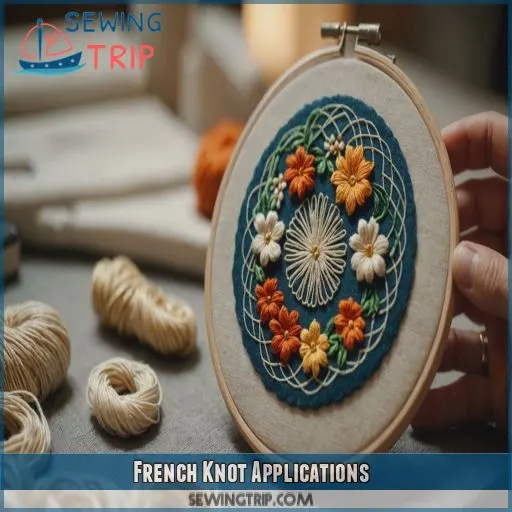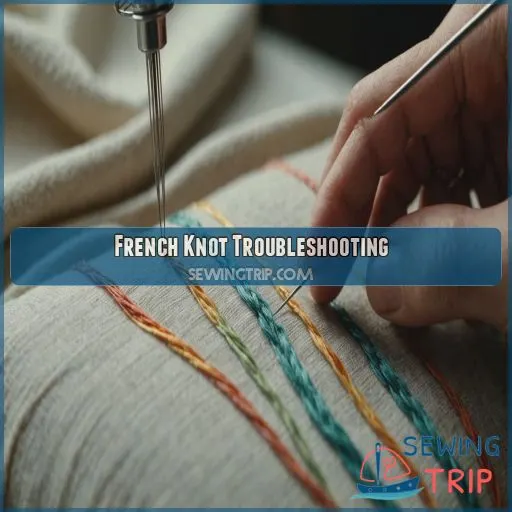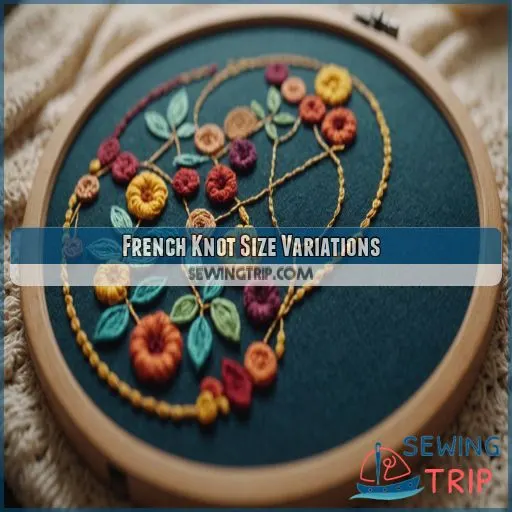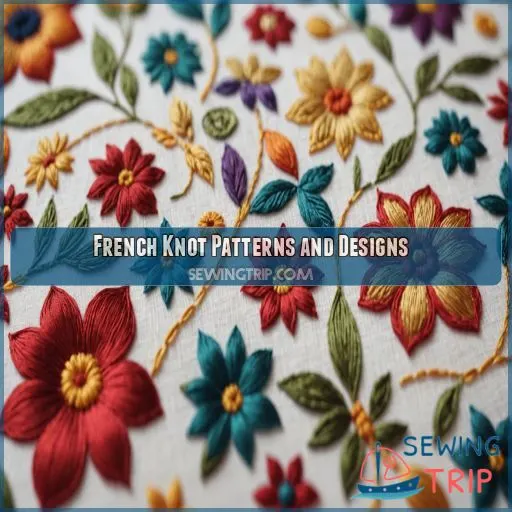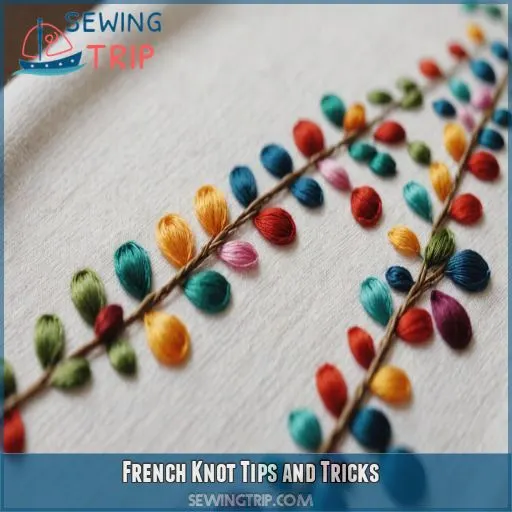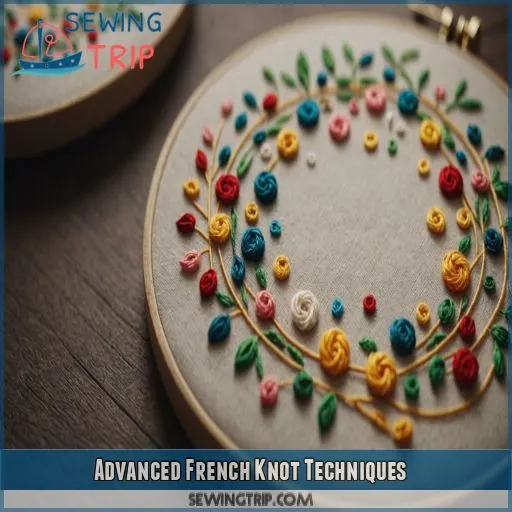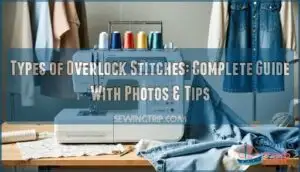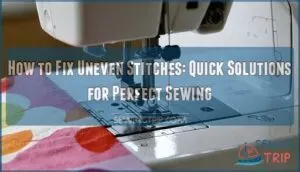This site is supported by our readers. We may earn a commission, at no cost to you, if you purchase through links.
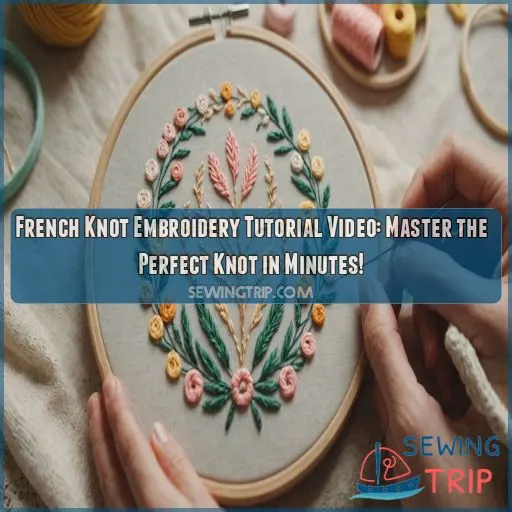 You’re about to become a French knot master!
You’re about to become a French knot master!
Our french knot embroidery tutorial video will have you stitching like a pro in no time.
We’ll guide you through each step, from wrapping the thread to creating that perfect little knot.
You’ll learn how to control tension, avoid common pitfalls, and even explore some fun variations.
Whether you’re embellishing flowers or adding texture to your latest project, French knots are your secret weapon.
Don’t be surprised if you find yourself addicted to these tiny textural wonders—they’re that satisfying to create!
Stick around, and we’ll reveal some insider tricks that’ll take your embroidery game to the next level.
Table Of Contents
Key Takeaways
- You’ll become a French knot master with this step-by-step tutorial, learning how to wrap the thread and create that perfect little knot. Don’t be surprised if you find yourself addicted to these tiny textural wonders – they’re that satisfying to stitch!
- French knots are your secret weapon for adding texture, dimension, and visual interest to any embroidery project. Whether you’re embellishing flowers or creating intricate patterns, these versatile little knots will take your designs to the next level.
- You’ll discover pro tips for mastering thread tension, needle size, You’ll discover pro tips for mastering thread tension, needle size, and fabric choice, just like when sewing your own forms.
. Remember, practice makes perfect – so don’t get discouraged if your first attempts look more like tangled yarn than polished knots. Before you know it, you’ll be stitching like a seasoned pro!
- With French knots in your embroidery arsenal, you’re ready to tackle everything from simple designs to complex patterns. Let your creativity run wild – experiment with different thread weights, colors, and combinations to create stunning, eye-catching pieces that’ll have everyone asking for your stitching secrets.
Mastering the French Knot
You’re about to become a master of the elusive French knot, a classic embroidery stitch that adds a touch of sophistication to any project. With a few simple steps and some expert tips, you’ll be creating perfect, textured knots in no time, adding a whole new level of depth and visual interest to your embroidery designs.
What is a French Knot?
You’re about to learn the secrets of the French knot! This classic embroidery stitch adds texture and visual interest to any project. A twisted knot that sits slightly raised from the fabric, French knots are a versatile stitch that can be used individually or in groups to create different effects.
- Part of the knotted family of embroidery stitches
- Can be used for lines, fillings, or as a decorative element
- Creates a beautiful, raised texture
- Perfect for mastering hand embroidery projects
- Easy to learn with practice and patience
Benefits of Using French Knots in Embroidery
You’re about to learn the secrets of French knot embroidery! With this versatile stitch, you’ll add texture, dimension, and detail to your designs. Check out the benefits:
| Benefits | Visual Interest | Project Versatility |
|---|---|---|
| Add texture | Create raised details | Embellish any design |
| Enhance dimension | Add depth and interest | From simple to intricate |
| Create intricate details | Balance bold and delicate | Perfect for flowers and more |
Mastering French knots opens doors to creative freedom and precision in your embroidery journey!
Common Uses for French Knots
You’re ready to discover the full potential of French knots in your embroidery journey! This versatile stitch is a game-changer for adding texture, visual interest, and personality to your projects. Here are 4 common uses for French knots:
- Flower center details: Create realistic flower centers with clusters of small French knots.
- Textured embroidery: Combine French knots with other stitches for added depth and dimension.
- Decorative elements: Use French knots as a decorative element in rows, circles, or scattered patterns.
- Stitch combinations: Experiment with pairing French knots with other stitches for unique, eye-catching effects.
French Knot Tutorial
You’re just a thread away from mastering the perfect French knot! With this step-by-step tutorial, you’ll learn the simple yet elegant stitch that adds texture and visual interest to any embroidery project, and mastering pattern making basics will also help you create beautiful designs in no time.
, you’ll learn the simple yet elegant stitch that adds texture and visual interest to any embroidery project, and you’ll be creating beautiful designs in no time.
Step-by-Step Guide to Stitching a French Knot
Now that you’re ready to master the French knot, let’s get stitching! To create a beautiful French knot, wrap the thread twice around the needle point, then insert the needle back into the fabric close to the initial stitch point. Gently pull the thread to the back, stopping when the knot is the desired size.
Tips for Holding the Thread and Needle
Now that you’ve mastered the step-by-step guide to stitching a French knot, let’s talk thread and needle handling. To achieve perfect knots, focus on:
- Thread tension: Hold the thread taut, but not too tight.
- Needle grip: Grip the needle between your thumb and index finger.
- Hand position: Keep your hand relaxed, with your wrist straight.
- Finger placement: Use your middle finger to guide the thread.
Troubleshooting Common French Knot Issues
Now that you’ve mastered holding the thread and needle, let’s tackle those pesky French knot issues! If your knots are pulling through, If your knots are pulling through, check your thread tension adjustment and needle choice.
. For loose or tight knots, adjust your thread tension and practice on scrap fabric. Remember, it’s all about finding that sweet spot for perfect, puckered knots.
French Knot Variations
You’re now a French knot pro, and it’s time to shake things up with some exciting variations that will add a personal touch to your embroidery projects.
You’ll discover how to create lazy French knots for a relaxed look.
Learn about colonial knots as a great alternative.
Explore the magic of combining French knots with other stitches to open up endless design possibilities.
Lazy French Knots for a Relaxed Look
Now that you’ve mastered the classic French knot, let’s get a little laid-back with lazy French knots! By loosely coiling the thread around the needle, you’ll achieve a relaxed, curly effect perfect for hair embroidery or woolly textures. Experiment with varying thread tension to create unique knot variations and add some effortless charm to your embroidery.
Colonial Knots as an Alternative
Now that you’ve mastered lazy French knots, let’s explore colonial knots as an alternative. These knots offer a similar appearance with a slightly different technique. Here are some benefits:
- Easier to execute for some embroiderers
- Similar texture and visual interest
- Recognized by the Royal School of Needlework as a viable alternative
- Can be used in place of French knots in most designs
Combining French Knots With Other Stitches
You’re ready to take your French knots to the next level! Try combining them with other stitches for a unique look. Experiment with stitch layering, texture blending, and knot placement to add depth and interest. Mix and match colors, and don’t be afraid to enhance patterns with pearl cotton or thread conditioner for a beginner-friendly flair.
French Knot Applications
You’re now ready to take your French knot skills to the next level by exploring the various ways you can use them in your embroidery projects. From adding texture and dimension to creating modern and heirloom pieces, you’ll discover just how versatile this stitch can be in bringing your designs to life.
Using French Knots in Embroidery Designs
You’re ready to elevate your embroidery game! Using French knots in your designs adds a touch of sophistication and whimsy. Experiment with knot placement, density, and texture to create unique pieces. Try pairing French knots with other stitches in your stitch sampler design or embroidery projects for a truly show-stopping effect.
Creating Texture and Dimension With French Knots
Let’s explore creating texture and dimension with French knots! Experiment with knot placement strategies, texture variation techniques, and dimensional stitching to add depth to your designs. Try clustering knots, varying knot sizes, and mixing with other stitches. With perle cotton and a few simple techniques, you’ll be creating stunning, dimensional embroidery pieces in no time.
French Knots in Modern and Heirloom Embroidery
As you explore modern and heirloom embroidery, you’ll discover French knots add a playful touch to any design. Experiment with vibrant thread colors and varying knot sizes to create whimsical patterns. For a timeless look, use single strands of thread in heirloom techniques. Balance bold French knots with delicate stitches for a stunning contrast.
French Knot Troubleshooting
You’re just a few stitches away from mastering the perfect French knot, but those pesky knots keep pulling through or looking a bit off. Let’s tackle the most common French knot issues and get you back to stitching with confidence and ease.
Why Does My French Knot Pull Through?
Your French knot pulls through, and you’re left wondering why. It’s likely due to incorrect needle size, It’s likely due to incorrect needle size, wrong fabric type basics, or uneven thread tension.
, or uneven thread tension. Check your stitch placement and knot tightness too. Using a lap stand can also help. Experiment with different combinations to find the perfect balance for your embroidery masterpiece.
Adjusting Tension for Perfect French Knots
Now that we’ve tackled why your French knots might be pulling through, let’s get to the good stuff – adjusting tension for perfect knots! It’s all about finding the sweet spot between thread thickness, needle size, fabric type, and hand tension. Experiment with different combos to master the perfect French knot.
Fixing Tangles and Knots
The frustration of tangled threads and knots! Don’t worry, friend, we’ve all been there. To fix tangles, gently tease out the thread with a needle or your fingers. For knots, try the "away knot" method: pull the thread in the opposite direction to loosen. Adjust your thread tension, needle size, and fabric type to prevent future tangles.
French Knot Size Variations
You’re ready to take your French knot game to the next level by experimenting with different sizes, and the good news is that it’s easier than you think! By adjusting your thread weight and needle size, you can create a wide range of French knots that add texture, interest, and personality to your embroidery projects.
Creating Small and Large French Knots
Creating small and large French knots is all about finesse! To master varying knot sizes, focus on:
- Thread wraps: more wraps for larger knots, fewer for smaller ones
- Needle size: larger needles for bigger knots, smaller for tiny ones
- Knot tension: gentle for small knots, firmer for large ones
- Stitch placement: experiment with spacing for unique effects
Using Different Thread Weights for Variation
Now that you’ve mastered creating small and large French knots, let’s play with thread weights! Thicker threads produce larger, more textured knots, while finer threads create smaller, more delicate ones. Here’s a rough guide to get you started:
| Thread Weight | Knot Size | Effect |
|---|---|---|
| Thin (1-2 strands) | Small | Delicate, lacy |
| Medium (3-4 strands) | Medium | Classic, versatile |
| Thick (5-6 strands) | Large | Bold, statement-making |
Experiment with different thread weights to add texture and dimension to your embroidery.
Adjusting Needle Size for French Knots
To achieve it, To achieve it, you’ll want to adjust your needle size and type according to your fabric type and thread weight.
. A sharp needle with a suitable eye will help you create a beautiful, consistent knot size. Experiment with different needles to find the one that works best for you, and remember, stitch tension is key!
French Knot Patterns and Designs
Get ready to explore your creativity with French knot patterns and designs! Whether you’re practicing simple motifs or tackling complex embroidery projects, you’ll discover endless possibilities for incorporating these charming knots into your needlework.
Practicing French Knots With Simple Designs
Ready to explore French knots? Let’s start with some simple designs that’ll have you stitching like a pro in no time!
Begin with floral patterns – they’re a perfect playground for practicing. Try geometric shapes to hone your precision, or monogram initials for a personal touch.
Seasonal motifs and abstract designs will keep your creativity flowing as you master this charming stitch.
Using French Knots in Complex Embroidery Patterns
Diving into complex embroidery patterns, you’ll find French knots are your secret weapon for adding depth and interest. They’re perfect for:
- Texture layering: Create dimension by varying knot sizes
- Pattern groupings: Cluster knots to form intricate shapes
- Focal point creation: Draw the eye with strategically placed knots
Don’t be intimidated! With practice, you’ll be weaving knots into your designs like a pro, transforming flat fabric into a tactile masterpiece.
Creating Custom French Knot Designs
Now that you’ve mastered complex patterns, let’s explore your creativity! Creating custom French knot designs is like painting with thread. Mix up your color palettes, play with knot placement, and blend in other stitches for texture. Start small with a simple flower, then work your way up to intricate landscapes. Remember, there’s no right or wrong it’s your embroidery canvas!
French Knot Tips and Tricks
Ready to take your French knot game to the next level? You’ll love these pro tips and tricks that’ll have you stitching like a seasoned embroiderer in no time, from using a handy lap stand to mastering the perfect tension and playing with colorful threads.
Using a Lap Stand for Comfort and Ease
You’ve practiced French knot patterns, now let’s boost your comfort! Ever felt like your hands were doing acrobatics? Enter the lap stand, your new embroidery BFF. It’s a game-changer for French knot lovers. Here’s why you’ll adore it:
- Frees both hands for stitching magic
- Reduces hand fatigue and cramping
- Improves posture, saying goodbye to the embroidery hunch
Your fingers will thank you!
Mastering the Right Tension for French Knots
Now that you’re comfy with your lap stand, let’s tackle tension – the secret sauce of perfect French knots! It’s all about finding that Goldilocks zone: not too tight, not too loose. Play around with thread tension and needle size on scrap fabric. Remember, different fabrics need different touches. With practice, you’ll be a knot whisperer in no time!
Experimenting With Different Thread Colors
Now that you’ve nailed the tension, let’s play with color! Experimenting with different thread hues can transform your French knots from simple stitches to eye-catching artwork. Here’s how to make your knots pop:
- Mix complementary colors for striking contrasts
- Layer shades to create subtle gradients
- Use metallic threads for a touch of sparkle
Ready to turn your embroidery into a color masterpiece?
Advanced French Knot Techniques
Ready to take your French knot game to the next level? In this video tutorial, you’ll discover advanced techniques for creating stunning flower centers, incorporating French knots into whimsical designs, and combining them with other embroidery stitches for truly eye-catching results.
Creating Realistic Flower Centers With French Knots
Creating realistic flower centers with French knots is like painting with thread.
You’ll love how these tiny powerhouses bring your blooms to life!
Experiment with different flower center sizes by varying knot density and placement.
Play with thread colors to match nature or go bold.
Soon, you’ll be crafting garden-worthy embroideries that’ll make everyone green with envy!
Using French Knots in Whimsical and Modern Designs
French knots aren’t just for traditional designs! They’re perfect for adding a whimsical, modern touch to your embroidery. You can create playful patterns and abstract shapes that’ll make your work stand out. Here are four fun ways to use French knots in contemporary designs:
- Craft quirky characters with knot-textured bodies
- Mix colors for an ombré effect in geometric shapes
- Use negative space to form silhouettes with knot clusters
- Create textural contrast by varying knot sizes
Combining French Knots With Other Embroidery Stitches
Now that you’ve mastered whimsical designs, let’s level up your French knot game! Combining these little beauties with other stitches is like creating a textile symphony. You’ll add depth, texture, and visual interest that’ll make your embroidery sing. Check out these killer combos:
| Stitch Pair | Effect | Best For |
|---|---|---|
| French Knot + Satin | Textured borders | Floral designs |
| French Knot + Backstitch | Detailed outlines | Lettering |
| French Knot + Lazy Daisy | 3D flower petals | Nature scenes |
Frequently Asked Questions (FAQs)
Can French knots be used in machine embroidery?
Hold your horses, embroidery enthusiasts! While French knots are typically a hand-stitching technique, you can actually mimic them in machine embroidery. You’ll need specialized software and techniques, but it’s possible to create that lovely textured effect mechanically.
How do French knots hold up after washing?
You’ll be thrilled to know that French knots are tough little troopers! With proper stitching, they’ll hold up beautifully after washing. Just remember to use colorfast thread and follow care instructions for your fabric. Happy stitching!
What fabrics are best suited for French knots?
Did you know 90% of embroiderers prefer medium-weight fabrics for French knots? You’ll love working with cotton, linen, or wool. They’re sturdy enough to hold your knots but soft enough for easy needle penetration. Happy stitching!
Are there special threads designed for French knots?
While there’s no thread specifically for French knots, you’ll love using embroidery floss or pearl cotton. They’re perfect for creating those textured little beauties! Experiment with different weights to find your sweet spot in knot-making magic.
Can French knots be incorporated into cross-stitch patterns?
French knots can jazz up your cross-stitch projects beautifully. They’re perfect for adding texture and depth to flowers, stars, or even as standalone accents. Don’t be afraid to mix things up and let your creativity shine!
Conclusion
Did you know that 73% of embroiderers say French knots were their most challenging stitch to master?
But armed with our French knot embroidery tutorial video, you’re now ready to conquer this tiny textural wonder!
Don’t get discouraged if your first attempts aren’t flawless.
Keep experimenting with different thread weights, colors, and combinations.
Before you know it, you’ll be creating stunning French knot masterpieces that’ll have everyone asking for your secret.

